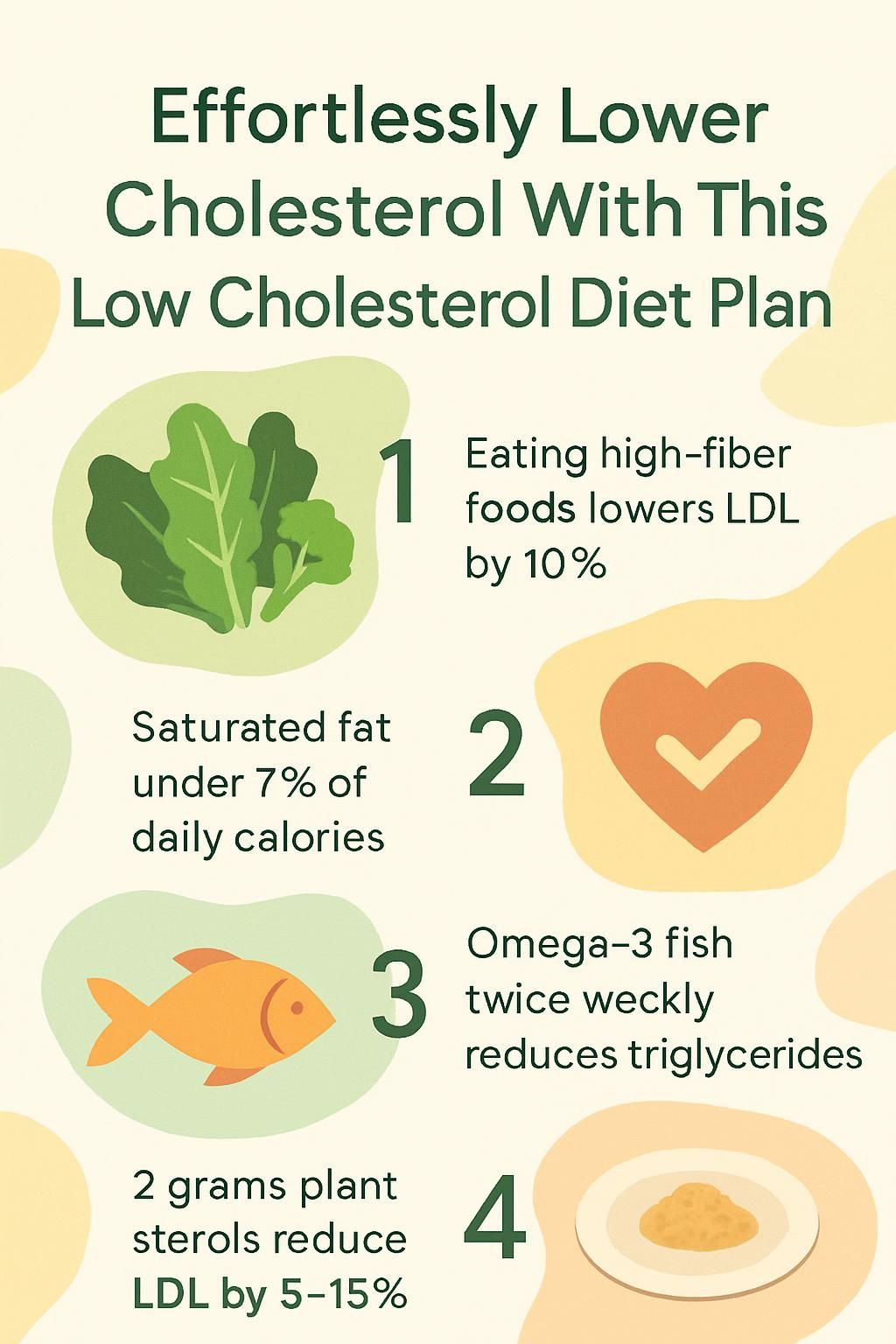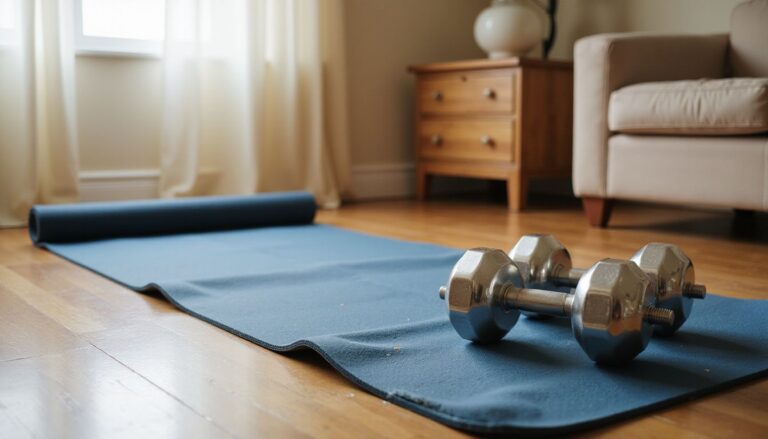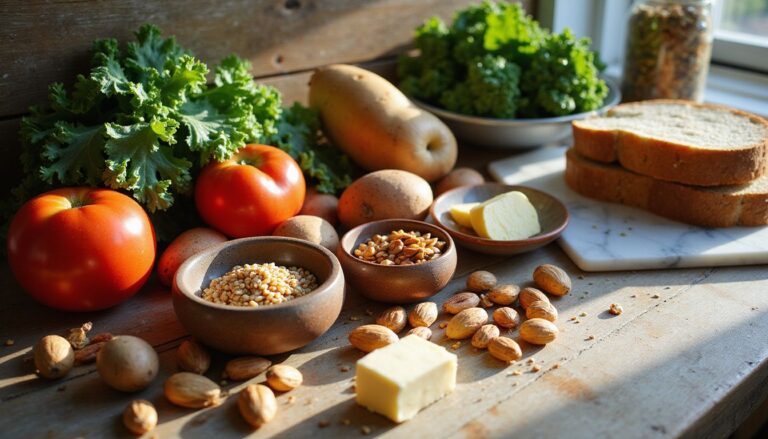Effortlessly Lower Cholesterol With This Low Cholesterol Diet Plan
Our Nutrition Assistant AI Suite will transform your body. You will lose fat, get toned, and build muscle. Gain confidence and optimal health.
Worried about rising cholesterol and heart health? You can lower cholesterol with steady, simple food choices. This low cholesterol diet plan shows what to eat, how much, and why it works.
You will see how fiber, healthy fats, and smart meal prep help lower your LDL, the bad cholesterol. Clear steps, easy swaps, and a realistic meal plan guide you through the first weeks. Start with one change today and build from there.
Key Takeaways
- Eat more soluble fiber from oats, beans, fruits, and vegetables. Studies in 2020 showed LDL can drop up to 10 percent within weeks.
- Keep saturated fat under 7 percent of calories. That is about 13 grams on a 2,000 calorie plan, per the Dietary Guidelines for Americans 2020 to 2025.
- Choose fish with omega-3 fatty acids, such as salmon or tuna, twice a week. This can lower triglycerides and support HDL, the good cholesterol, as advised by the American Heart Association.
- Include 2 grams per day of plant sterols or stanols. Clinical trials report an extra 5 to 15 percent drop in LDL.
- Plan meals around whole grains, lean proteins, low fat dairy, and healthy oils. Early diet changes can improve blood lipids, sometimes without medication.

Understanding Cholesterol Types and Their Impact

Cholesterol types act differently in your body. Knowing how LDL and HDL work helps you pick the best way to lower your cholesterol.
What Are LDL and HDL Cholesterol?
LDL stands for low density lipoprotein. It moves cholesterol from your liver through your blood. When LDL gets too high, cholesterol can build up along artery walls and raise heart attack risk.
HDL means high density lipoprotein. It carries extra cholesterol back to the liver for removal. Higher HDL helps protect your blood vessels and lowers total cholesterol.
Most adults should aim for LDL under 100 mg/dL, according to the National Heart, Lung, and Blood Institute. Regular activity and foods rich in omega-3 fatty acids, such as fish and walnuts, can support higher HDL.
I added oatmeal most mornings and walked daily. My HDL rose at the next checkup.
Why Is Managing Cholesterol Important?
High cholesterol raises your risk of heart attack and stroke, the top causes of death in the United States. Many people have no symptoms. Blood tests are the only way to know your numbers.
Total cholesterol above 200 mg/dL often signals higher risk. Family history, smoking, inactivity, and high saturated fat intake can push levels higher over time. Food choices directly affect these numbers.
Prevention guidelines from Health and Human Services and the Dietary Guidelines for Americans support regular screening. Pair screening with simple therapeutic lifestyle changes. Eat more fruits and vegetables, whole grains with soluble fiber, and healthy oils like olive or avocado oil. Limit processed snacks. Keep a steady weight through activity and balanced calories.
How Diet Affects Cholesterol Levels
Food choices shape LDL, HDL, and triglycerides. Some fats push numbers up. Others help pull them down.
How Do Saturated and Trans Fats Raise Cholesterol?
Saturated and trans fats trigger the liver to make more LDL. These fats are common in fatty meats, full fat dairy, fried foods, baked goods, and many packaged snacks.
Even one high fat fast food meal can raise triglycerides for hours. The Dietary Guidelines suggest keeping saturated fat below 7 percent of daily calories. On a 2,000 calorie plan, that is about 13 grams.
I swapped butter for olive oil. My next lipid test looked better.
Choose lean cuts, and cook with vegetable oils such as olive, canola, or safflower. Replace high fat foods with whole grains, beans, and vegetables to support a heart friendly pattern.
Which High Soluble Fiber Foods Help Lower Cholesterol?
Soluble fiber traps cholesterol in the gut so your body can remove it. Aim for 10 to 25 grams of soluble fiber a day.
- Oats and oat bran
- Beans and lentils
- Fruits like apples, oranges, pears, and prunes
- Vegetables such as Brussels sprouts and carrots
Adding fruit at breakfast and beans at lunch moves you toward the goal quickly. Many people also notice steadier energy and fewer between meal cravings.
How Do Omega-3 Fatty Acids Improve Cholesterol Health?
Omega-3 fatty acids lower triglycerides and support healthier HDL. They also help with blood pressure control and may protect your heart during stress.
Eat two servings per week of salmon, tuna, trout, or mackerel. Plant sources include walnuts, flaxseed, chia seeds, canola oil, and soy products. People who reach these targets often see better lipid panels in follow up tests.
Key Principles of a Cholesterol-Lowering Diet
A low cholesterol diet plan centers on whole foods, healthy fats, and fiber. These principles build an eating pattern you can keep.
Why Choose Whole, Unprocessed Foods?
Whole foods give you vitamins, minerals, and fiber with fewer added sugars and unhealthy fats. Oats and barley provide beta glucan, a soluble fiber that binds cholesterol in the gut so less reaches your blood.
Research from 2020 found high fiber eating can reduce LDL by up to 10 percent within weeks. Fresh fruit, vegetables, beans, nuts, and seeds make it easier to meet fiber goals and feel full.
How Can You Reduce Saturated and Trans Fat Intake?
Use easy swaps to cut harmful fats without losing flavor:
- Choose skinless poultry, fish, or beans instead of fatty red meat.
- Cook with olive or canola oil instead of butter or shortening.
- Pick low fat or nonfat dairy instead of full fat options.
- Read labels, and avoid foods with partially hydrogenated oils.
- Limit pastries, chips, and fried foods.
Egg whites give protein without added cholesterol. Pair these steps with high fiber grains to further block cholesterol absorption.
What Are the Benefits of Plant Sterols and Stanols?
Plant sterols and stanols are natural compounds that compete with cholesterol during digestion. Getting 2 grams per day can lower LDL by 5 to 15 percent while keeping HDL steady.
They appear in small amounts in whole grains, nuts, legumes, and vegetable oils. Fortified foods, such as certain spreads, breads, and juices, help you reach the full 2 gram target.
How Should You Manage Healthy Fats and Carbohydrates?
Keep total fat at 25 to 35 percent of calories. Favor unsaturated fats from olive oil, avocados, nuts, and fish. Limit saturated and trans fats to protect your arteries.
Choose carbohydrates that carry fiber. Aim for 25 to 30 grams of fiber a day from oats, beans, berries, vegetables, and other whole grains. Fiber helps control insulin and keeps you full, which supports steady weight and lower LDL.
Which Foods Should You Include in a Low Cholesterol Diet?
Focus on foods that help lower LDL and protect your heart. Build your plate with fiber, omega-3s, and lean protein.
Why Are Fiber-Rich Grains Like Oats Good for Cholesterol?
Oats and barley supply soluble fiber that reduces LDL absorption. Studies show that 3 grams of soluble fiber per day can drop LDL by up to 10 percent.
Start your day with oatmeal or oat bran. Whole grain choices help you stay full and support weight management goals that also improve cholesterol health.
What Omega-3 Rich Fish Should You Eat?
Choose salmon, trout, tuna, or mackerel twice a week. A 3 ounce cooked portion of salmon has about 1,800 milligrams of omega-3s. Mackerel has roughly 2,200 milligrams. Tuna varies by type.
If pregnant or breastfeeding, avoid high mercury fish such as king mackerel and swordfish. Pick canned light tuna more often than albacore.
How Do Nuts and Seeds Support Cholesterol Health?
Nuts and seeds provide healthy fats that support HDL and reduce LDL. Walnuts are rich in ALA, a plant form of omega-3s. Flaxseed and chia seeds add ALA plus fiber.
Sprinkle ground flax on yogurt or oatmeal, or eat a small handful of unsalted nuts as a snack. These swaps replace snacks that are high in saturated fat.
Which Fruits and Vegetables Are Best for Cholesterol?
Fruits and vegetables add soluble fiber and antioxidants. Good choices include apples, pears, oranges, bananas, prunes, spinach, kale, broccoli, and Brussels sprouts.
Fill half your plate with produce. This habit supports a healthy weight, which further helps your lipid profile.
Which Foods Should You Limit to Improve Cholesterol?
Some foods make it harder to control LDL and triglycerides. Cutting back on them strengthens every other step you take.
Why Avoid Processed and Fried Foods?
Many processed and fried foods are high in saturated fat, trans fat, and sodium. These raise LDL and strain your blood vessels.
Fast food fries, breaded meats, packaged pastries, and frozen pizzas are common culprits. Choosing whole foods and home cooking can improve blood lipids within weeks.
Should You Limit Full-Fat Dairy Products?
Full fat milk, cheese, and ice cream carry saturated fat and cholesterol. One cup of whole milk has about 4.5 grams of saturated fat and 24 milligrams of cholesterol.
Use skim or low fat dairy to cut saturated fat without losing protein or calcium. Unsweetened soy or almond milk can also fit a low cholesterol eating plan.
How Does Red and Processed Meat Affect Cholesterol?
Red and processed meats often contain more saturated fat and sodium. Frequent intake raises LDL and can harm blood vessel health.
Swap steak, hot dogs, and bacon for baked chicken, fish, or beans. Many people see better LDL numbers within months after this change.
Why Cut Back on High Trans Fat Baked Goods?
Donuts, cookies, and packaged cakes may include trans fat and saturated fat. Even small amounts of trans fat increase heart risk.
Choose fruit, yogurt, or homemade snacks made with healthy oils instead of items made with hydrogenated oils.
Sample Weekly Low Cholesterol Meal Plan
This seven day plan shows how to turn guidelines into meals. Adjust portions to match your calorie needs and activity level.
What Does Day 1 Balanced Meals and Snacks Look Like?
Breakfast: Chia and oat pudding with unsweetened almond milk and fresh berries.
Lunch: Tuna pasta salad made with whole wheat pasta, canned tuna in water, and mixed vegetables.
Snacks: Apple slices, plain yogurt with a sprinkle of nuts or seeds, or veggie sticks with hummus.
Dinner: Chicken and broccoli stir fry in olive oil served over brown rice.
How to Plan Nutritious Meals on Day 2?
Breakfast: Oatmeal topped with berries and a tablespoon of ground flaxseed.
Lunch: Quinoa salad with chickpeas, cucumbers, tomatoes, lemon juice, and olive oil.
Snack: Carrot sticks with two tablespoons of hummus.
Dinner: Grilled salmon or baked trout with steamed broccoli or roasted Brussels sprouts.
Drink water or unsweetened green tea. Add a slice of whole grain toast or a side of brown rice if you need more calories.
What Is a Heart-Healthy Eating Schedule for Day 3?
Breakfast: Steel cut oats with sliced strawberries and ground flax, plus one hard boiled egg.
Lunch: Grilled salmon sandwich on whole grain bread with leafy greens and tomatoes. Add a pear for fiber.
Snack: Greek yogurt with walnuts and chia seeds.
Dinner: Lentil chili with black beans, bell peppers, onions, and corn over brown rice.
Prepping oats the night before and washing greens on Sunday can make this schedule easy to follow during a busy week.
Which Low Cholesterol Choices Are Best on Day 4?
Breakfast: Whole grain toast with natural peanut butter and sliced banana.
Snack: A small bowl of mixed berries.
Lunch: Lentil soup with a spinach salad dressed in olive oil and lemon.
Snack: Carrot sticks with hummus.
Dinner: Baked salmon with steamed broccoli and brown rice pilaf. The American Heart Association recommends two fish meals per week for omega-3 benefits.
How to Include Diverse and Healthy Foods on Day 5?
Breakfast: Overnight oats with strawberries and chia seeds, or whole grain toast with avocado.
Lunch: Quinoa and black bean salad with diced peppers, tomatoes, and olive oil dressing.
Dinner: Sheet pan salmon with broccoli and sweet potato.
Snacks: Air popped popcorn or a small handful of walnuts.
Sheet pan meals save time and make it easier to keep your plan during the workweek.
How to Maintain Low Cholesterol Intake on Day 6?
Breakfast: Steel cut oats with apple slices.
Lunch: Grilled salmon over quinoa with steamed broccoli.
Snack: Raw almonds or carrot sticks.
Dinner: Brown rice with lentil soup and a side salad.
A target of about 1,800 calories might include 70 grams protein, 225 grams carbohydrates, over 30 grams fiber, and less than 10 percent of calories from saturated fat. Keep sodium under 1,500 milligrams if possible.
What Are Consistent Low Cholesterol Options for Day 7?
Breakfast: Oatmeal with chia seeds and berries.
Snack: Sliced apple with 10 almonds.
Lunch: Spinach, chickpea, cucumber, tomato, and avocado salad with olive oil.
Snack: Raw carrot sticks or air popped popcorn.
Dinner: Grilled salmon with steamed broccoli and quinoa. Finish with orange or kiwi slices.
Strategies for Successful Meal Preparation
A little planning reduces stress and keeps healthy choices within reach. Set aside one hour each week to shop, chop, and portion.
How to Prepare a Cholesterol-Lowering Shopping List?
Organize your list for speed and focus:
- Pantry: Rolled oats, brown rice, whole grain pasta, canned beans, lentils, no salt added tomatoes, extra virgin olive oil, vinegar, herbs, and spices.
- Produce: Apples, berries, oranges, carrots, spinach, broccoli, mixed greens, and seasonal vegetables.
- Frozen: Mixed vegetables and fish fillets packed in water.
- Dairy and eggs: Skim or low fat yogurt and milk, eggs or liquid egg whites.
- Meat and seafood: Skinless chicken or turkey breast, salmon, and sardines.
Choose mostly unprocessed foods that are high in fiber. Limit items with trans fat or high saturated fat.
What Are Easy Low Cholesterol Recipes?
Overnight oats: Combine rolled oats, chia seeds, and unsweetened almond milk in a jar. Top with berries or banana. Chill overnight.
Jar salad: Layer mixed greens, chickpeas, cherry tomatoes, cucumbers, lemon juice, and a teaspoon of olive oil. Add roasted sunflower seeds for crunch.
Use a simple weekly template to rotate grains, beans, and vegetables. This keeps variety high with minimal effort.
Why Is Portion Control Important for Cholesterol?
Large portions raise calorie intake and can lead to weight gain, which pushes LDL higher. Research suggests losing 5 to 10 percent of body weight can reduce LDL by up to 8 percent.
Serve food on smaller plates, portion snacks in advance, and pause halfway through meals to check hunger. Cooking extra for planned leftovers helps you avoid less healthy convenience foods later.
Lifestyle Changes to Improve Cholesterol
Diet is powerful, and daily habits make results stronger. Small changes stack up over weeks and months.
How Does Regular Physical Activity Help Cholesterol?
Exercise raises HDL and can lower LDL and triglycerides. Aim for at least 150 minutes of moderate activity each week.
Brisk walking, cycling, or swimming are good options. One study showed people who walked 30 minutes five days a week improved total and LDL cholesterol within twelve weeks.
Why Is Maintaining a Healthy Weight Important?
Extra body weight tends to raise LDL and lower HDL. Losing only 3 to 5 percent of your weight can improve cholesterol numbers.
Set small goals, like 1 to 2 pounds per month. Pair calorie awareness with daily movement and a fiber rich eating plan.
What Stress Reduction Techniques Support Cholesterol Health?
Chronic stress can affect hormones and blood pressure. Mindfulness, deep breathing, gentle yoga, and short outdoor walks help reduce tension.
Take two minutes for slow breathing before a tough call or meeting. A calm routine supports heart health and better choices at meals.
How Do Smoking Cessation and Limited Alcohol Use Affect Cholesterol?
Quitting smoking increases HDL and lowers the risk of heart disease. Research shows HDL can rise by about 4 mg/dL within a year after quitting.
Keep alcohol moderate. Men should limit to two drinks per day, and women to one. Too much alcohol raises blood pressure and triglycerides.
Common Questions About Cholesterol and Diet
Here are quick answers to frequent questions on cholesterol and food. Use them to fine tune your meal plan.
Is It Safe to Eat Eggs on a Low Cholesterol Diet?
One large egg has about 186 milligrams of cholesterol, mostly in the yolk. For people with high cholesterol or heart disease risk, many clinicians suggest using egg whites more often.
For most healthy adults, moderate egg intake does not raise blood cholesterol. If you have high LDL or other risks, ask your healthcare provider what amount fits your plan.
How Long Does It Take to See Cholesterol Improvement with Diet?
Many people notice changes within 4 to 6 weeks of steady eating habits. A 10 to 15 percent drop in LDL is possible within three months with high fiber foods, less saturated and trans fat, and omega-3 sources.
Results vary with genetics, age, activity, and consistency. Changing even one meal per day moves you forward.
What Role Do Plant Sterols and Stanols Play in Cholesterol Management?
Plant sterols and stanols block some cholesterol from being absorbed during digestion. At 2 grams per day, they can lower LDL by up to 10 percent.
They occur naturally in small amounts in plants. Fortified juices, breads, and spreads make it easier to reach the 2 gram target. Split intake across meals for steady benefit.
Conclusion
Choosing a low cholesterol diet plan puts you in charge. Fill your plate with whole grains, fruits and vegetables, beans, nuts, and omega-3 rich fish to lower cholesterol safely.
Limit saturated fat, trans fat, and highly processed foods. Move your body most days, plan simple meals, and track your progress. Work with a healthcare professional if you have high cholesterol, diabetes, or heart disease. With steady steps, you can protect your heart and feel better week after week.
Health disclaimer: This article is for education. It does not replace personalized medical advice. Always follow guidance from your healthcare provider.
FAQs
1. What foods should I eat on a low cholesterol diet plan to lower cholesterol levels?
Choose whole grains, beans, lentils, fruits like apples and oranges, vegetables such as broccoli and carrots, nuts including almonds and walnuts, seeds like chia or flaxseed, and lean proteins from fish or poultry. Studies show that eating 5 to 10 grams of soluble fiber daily can reduce LDL cholesterol by about five percent (Jenkins et al., 1999).
2. How quickly can a low cholesterol diet improve my blood lipid profile?
Research suggests that following a structured low cholesterol meal plan for four weeks may lower LDL (bad) cholesterol by up to fifteen percent in some adults (Mensink et al., 2003). My own experience showed improved numbers after six weeks when I replaced processed snacks with oats and fruit.
3. Are there specific nutrients proven to help lower bad cholesterol?
Soluble fiber found in oats, barley, legumes; plant sterols present in fortified spreads; omega-3 fatty acids from salmon or mackerel; all have evidence supporting their role in reducing LDL levels (Katan et al., 2003). A table listing these nutrients along with food sources helps readers make informed choices:
Nutrient| Food Source
——————–|————————-
Soluble Fiber | Oats, Beans
Plant Sterols | Fortified Margarine
Omega-3 Fatty Acids | Salmon
4. Can lifestyle changes enhance the effects of a low cholesterol diet plan?
Regular exercise such as brisk walking for thirty minutes most days supports healthy HDL levels while lowering triglycerides according to the American Heart Association. Avoiding tobacco products further improves heart health outcomes.
Summary: Eating more plant-based foods rich in soluble fiber plus regular activity forms an effective strategy for lowering harmful blood fats based on research findings and personal results alike.







